 |
 |
|||||||||||||||||||||
|
||||||||||||||||||||||
AZFO FIELD EXPEDITION
Big Lue Mountains & Gila River (Greenlee County)
May 17-18, 2014
By Eric Hough
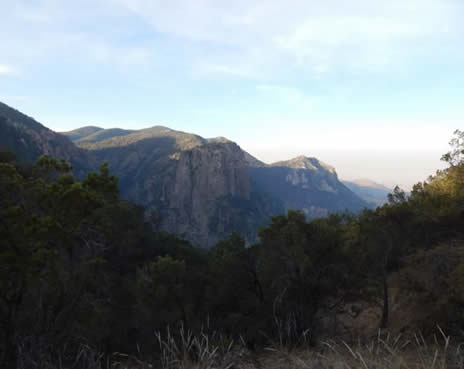 |
Blackjack Canyon, Big Lue Mtns. (© Eric Hough) |
On the weekend of May 16-18, 2014, I led an Arizona Field Ornithologists (AZFO) expedition over to the far eastern part of the state to very under-birded Greenlee County along the Arizona-New Mexico border. The focus of our survey efforts on this expedition were the Big Lue Mountains, a small mountain range at the southern tip of the Apache National Forest, situated south of the White Mountains and just north of the classic southeastern AZ "sky island" ranges. From desert-scrub and semi-desert grassland at the base of the mountains, the life zones proceed up through chaparral to pine-oak-juniper forest topping at around 7,000 ft. elevation on the tallest hills. The vegetation in the Big Lue Mountains is an overlap of plant species found in both the "Sky Islands" and White Mountains/ Mogollon Rim regions, with dominant tree species including ponderosa pine (Pinus ponderosa), Chihuahuan pine (P. leiophylla), two-needled Colorado pinyon pine (P. edulis) and apparent three-needled Mexican pinyon pines (P. cembroides), alligator juniper (Juniperus deppeana), and several oak species including silverleaf (Quercus hypoleucoides), netleaf (Q. rugosa), gray (Q. grisea), Emory (Q. emoryi), Arizona white (Q. arizonica), and Gambel (Q. gambelii). Chaparral communities here are dominated by scrub and other oak species (Q. turbinella), pointleaf manzanita (Arctostaphylos pungens), and beargrass (Nolina microcarpa). Riparian vegetation is limited in this mountain range, but dominant species include Arizona sycamore (Platanus wrightii), Fremont cottonwood (Populus fremontii), netleaf hackberry (Celtis reticulata), along with several other shrub species. Given the overlapping vegetation here, we were curious what overlapping avifauna might also be present in this seldom visited mountain range.
On Friday (May 16th) the two other participants of the expedition, Muriel Neddemeyer and Tim Marquardt, showed up ahead of me to secure a campsite for our group at Blackjack Campground off Hwy. 78 east of Clifton. Among typical pine-oak forest species, they also detected a male Magnificent Hummingbird at the campground hosts' feeders (a special thanks to Dave and Millie for graciously letting us sit with them to watch their feeders!). Early in the evening after I arrived, we briefly heard a Common Poorwill call before other natural nocturnal sounds were drowned out by neighboring campers' music. The loud music inconsiderately continued through 3:00am, but the silver lining of that unfortunate situation was that two-thirds of our group were still awake to hear a Mexican Whip-poor-will vocalize around 4:00am.
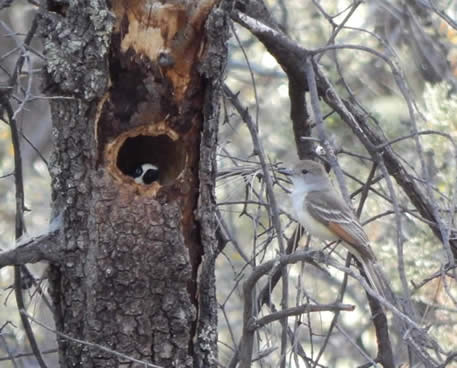 |
Acorn Woodpecker vs. Ash-throated Flycatcher (© Eric Hough) |
After very little sleep, we awoke with the dawn chorus on Saturday (May 17th) before 5:00am and surveyed first for birds around the campground after breakfast. Of the typical pine-oak forest breeding residents, we observed several territorial and paired up birds of multiple species, including Plumbeous Vireos, Black-throated Gray and Grace’s Warblers, Hepatic Tanagers, and Black-headed Grosbeaks. We also observed an interesting fight between a pair of Ash-throated Flycatchers and an Acorn Woodpecker over a nest cavity (the woodpecker was peeking its head out and the flycatchers were acting aggressively towards it, so perhaps the woodpecker overtook their nest). Additionally, we detected migrants still moving through, including a Warbling Vireo, a Townsend’s Warbler, and Western Tanagers. Still early in the morning, we headed just northeast up the highway to Martinez Ranch Rd. (Forest Rd. 212), which goes north from Hwy. 78 towards the San Francisco River. We explored only up to a corral less than 10 miles up the road where the road condition gets rocky and rough. In addition to stopping to look and listen for birds along the road, we also got out and walked about a quarter mile up Seep Spring Canyon, which contains more pine-oak-juniper forest habitat with the addition of Gambel oaks along the north-facing slope. In this area we observed Juniper Titmice carrying food for likely nestlings nearby, a female Hepatic Tanager carrying nesting materials while the male stood guard, agitated pairs of Rufous-crowned Sparrows with likely nests nearby, territorial Western Wood-Pewees, Gray Flycatchers, Cassin’s Kingbirds, and Painted Redstarts, and migrant Yellow-rumped and Wilson’s Warblers, Western Tanagers, and a Lazuli Bunting.
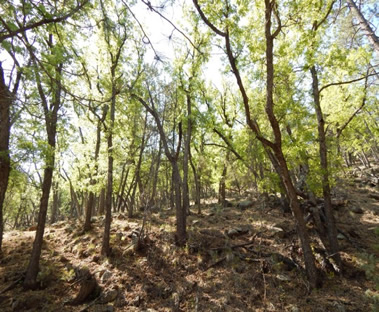 |
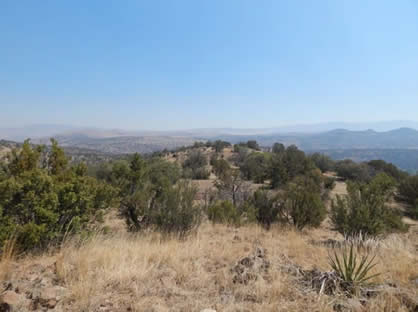 |
| A) Pine-oak forest in Seep Springs Canyon | B) juniper-oak savannah looking east into New Mexico (© Eric Hough) |
Farther up the road we passed through oak-juniper savannah with large patches of bunchgrasses that looked like perfect habitat for Montezuma Quail, but alas we were unable to detect this species. At the corral area where we ended up turning around before Dix Mesa, the vegetation transitions to more semi-desert grassland with scattered velvet mesquites at the ecotone with juniper-oak woodlands. Here we added a Rock Wren and Canyon Towhees to our list. Views of the rolling hills and mountains were obscured by the Skunk and Basin Fires burning to the west on the San Carlos Reservation, but luckily we didn't have to breathe in too much of it over the weekend.
 |
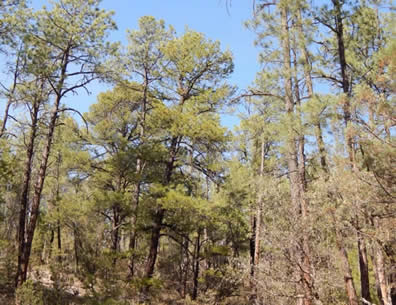 |
| A) Pine-oak forest at Blackjack Campground | B) Chihuahuan pines mixed in with ponderosa pines and oaks along nearby Maverick Hill Trail (© Eric Hough) |
We headed back to Blackjack Campground around noon for lunch and spotted a female Magnificent Hummingbird among the numerous Broad-tailed and Black-chinned Hummingbirds visiting the campground hosts' feeders. After short naps to combat the effects of sleep deprivation, we hiked northeast from the campground on the dirt road to the ATV trailhead that then travels southeast to Maverick Hill. Just past the campground we found a silent Olive-sided Flycatcher, an active Western
 |
Western Bluebird nest (© Muriel Neddemeyer) |
Bluebird nest in an old woodpecker hole, a family group of Mexican Jays with what sounded like begging young, and a pair of agitated White-breasted Nuthatches that likely had a nest nearby. Farther down the trail the habitat becomes more pine forest dominated in the narrow canyon bottoms that the trail follows, with several patches of Chihuahuan pines mixed in. In this area we found a Painted Redstart nest with eggs, a pair of Gray Flycatchers, and Tim had brief views of a possible male Rose-breasted Grosbeak that disappeared before Muriel and I could get on it. We also saw an interesting fight between a pair of Hepatic Tanagers with another female that left us intrigued. Below an old stone dam among the jagged rock formations in a bottleneck of White Mule Creek, we found stagnant puddles with Virginia’s and Black-throated Gray Warblers, and Rufous-crowned Sparrows nearby. Tim and I hiked another mile or two farther up to a higher ridgeline at just above 6,600 ft. elevation where we had views of Maverick Hill (my GPS showed it a little over a mile from where we were), the distant Pinaleño Mountains near Safford, AZ, and the distant Mogollon Mountains and other ranges in New Mexico. Smoke from the San Carlos Reservation wildfires continued to obscure views to the north. Birds encountered on this stretch were typical of the chaparral and pinyon-juniper-oak woodlands the trail had ascended through, including Mexican Jays, Bushtits, and Spotted Towhees. We turned around here, as it was getting late in the afternoon. On the hike down, an immature Northern Goshawk landed on a branch above us and afforded decent enough views before it took off. It seemed odd that in this pine-oak forest we did not detect any Hutton’s Vireos, Pygmy Nuthatches, or Dark-eyed Juncos, although the Breeding Bird Atlas also did not detect the nuthatches or juncos south of the White Mountains into this region either.
 |
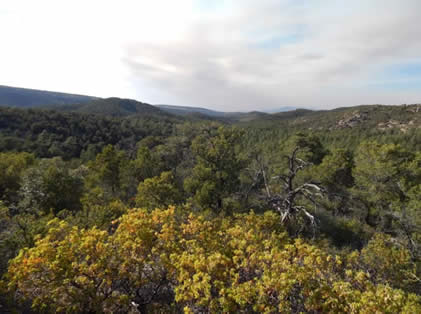 |
| A) Old rock dam at Phillips Tank along White Mule Creek | B) looking north from Maverick Hill Trail across the Big Lue Mtns. (© Eric Hough). |
Just after dusk the three of us headed back over to Martinez Ranch Rd. (Forest Rd. 212) for owling. Along the few mile stretch we surveyed, we detected an astonishing 10 Elf Owls here at an elevation of around 6,000 ft. (detections between 5,997-6,082 ft.), which is higher than the 5,600 ft. upper elevation limit found for the species during the AZ Breeding Bird Atlas surveys in the 1990's (since then Troy Corman has found them at ~5,750 ft. elevation elsewhere in Greenlee Co.). We also heard three Western Screech-Owls and one Flammulated Owl. No nightjars were heard around the campground that night, but we were all very tired after the previous night (luckily the campground was quiet this night!).
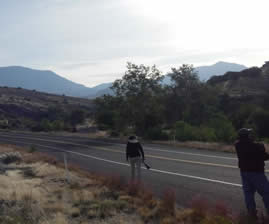 |
Hwy. 78 at Blackjack Creek, with Big Lue Mtns. in the background (© Eric Hough) |
On Sunday morning (May 18th) after breaking camp early, we headed back down Hwy. 78 on our way to survey along the Gila River at Duncan (also Greenlee Co.). Driving with the windows down along the switchbacks below Blackjack Campground, I heard singing Black-chinned and Black-throated Sparrows, saw a male Scott’s Oriole perched on a blooming agave stalk, and saw a Crissal Thrasher fly across the road. We stopped at a roadside pullout where Hwy. 78 crosses lower Blackjack Creek, finding a couple each of Brown-crested Flycatchers, Cassin’s Kingbirds, Bell’s Vireos, Summer Tanagers, Pyrrhuloxias, Blue Grosbeaks, and single Yellow and Lucy’s Warblers, and Hooded Oriole among a few other resident species. The only migrants were a Wilson’s Warbler and a ‘Mountain’ (dark-lored) White-crowned Sparrow. A Northern Mockingbird entertained us with its imitations of other Sonoran Desert bird species’ songs, including the comical sounds of a Lesser Nighthawk impression.
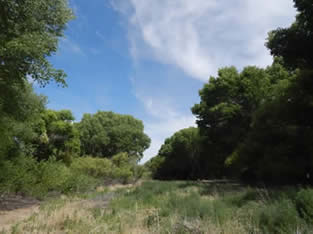 |
| Riparian cottonwood-willow forest along Gila River at Duncan (© Eric Hough) |
Along Hwy. 75 between Three Way and Duncan, we birded a roadside pullout and added a singing Warbling Vireo, Yellow-breasted Chats, and Northern Cardinals, plus some of the same species we had along Blackjack Creek including two handsome male Blue Grosbeaks.
Lastly, our group surveyed along the Gila River in Duncan, accessed off Old Virden Rd. just southeast of the bridge crossing of Hwy. 75 over the river. Highlights along here included nesting Great Blue Herons, a flyover flock of 25 White-faced Ibises, two Swainson’s Hawks fighting over food, Dusky and Pacific-slope Flycatchers, Brown-crested Flycatchers, Vermilion Flycatchers, Plumbeous, Bell’s and Warbling Vireos, Black-throated Gray, Townsend’s and Wilson’s Warblers, Summer and Western Tanagers, and Black-headed Grosbeaks among several other species. Muriel and Tim told me later they saw a silent Empidonax flycatcher on their way out that looked like a Willow Flycatcher to them.
After we parted ways, I made one more stop at the Duncan town park on the south side of Hwy. 70 just east of the Hwy. 75 intersection. Highlights here included Inca Doves, an active American Robin nest in a mulberry tree, Cedar Waxwings, Yellow-rumped Warblers, Western Tanagers, and a male Blue Grosbeak.
All in all, the expedition was successful in gathering some interesting data for an under-birded part of Arizona and we had fun doing it! Our full species lists have been entered into eBird (ebird.org) under the “AZFO Field Expeditions” account and Tim was able to get sound recordings of several species that will be uploaded onto xeno-canto.org and accessible for others to listen to, download, and view sonograms of. We hope you’ll join us on the next expedition!
Below is a comprehensive list of the number of individuals and breeding activity observed for the 103 species detected within the Big Lue Mountains (including lower Blackjack Creek in its foothills) and along the Gila River/Duncan area on this expedition:
| Big Lue Mountains | Gila River/Duncan | |||
|---|---|---|---|---|
| Species | # of Individuals |
*Breeding Activity |
# of Invidiuals |
*Breeding Activity |
| Gambel's Quail | 2 |
7 |
||
| Great Blue Heron | 2 |
ON |
||
| White-faced Ibis | 25 |
|||
| Turkey Vulture | 36 |
17 |
||
| Northern Goshawk | 1 |
|||
| Swainson's Hawk | 2 |
|||
| Red-tailed Hawk | 4 |
ON |
||
| Eurasian Collared-Dove | 17 |
C |
||
| White-winged Dove | 1 |
27 |
||
| Mourning Dove | 9 |
17 |
||
| Inca Dove | 5 |
|||
| Greater Roadrunner | 1 |
|||
| Flammulated Owl | 1 |
|||
| Western Screech-Owl | 3 |
P |
||
| Elf Owl | 10 |
P |
||
| Common Poorwill | 1 |
|||
| Mexican Whip-poor-will | 1 |
|||
| White-throated Swift | 4 |
|||
| Magnificent Hummingbird | 2 |
|||
| Black-chinned Hummingbird | 4 |
4 |
||
| Broad-tailed Hummingbird | 13 |
2 |
||
| Acorn Woodpecker | 7 |
PN |
||
| Gila Woodpecker | 2 |
|||
| Ladder-backed Woodpecker | 2 |
4 |
||
| Hairy Woodpecker | 6 |
|||
| Northern Flicker | 2 |
|||
| American Kestrel | 1 |
|||
| Olive-sided Flycatcher | 1 |
|||
| Western Wood-Pewee | 14 |
P |
1 |
|
| Willow Flycatcher | 1 |
|||
| Gray Flycatcher | 5 |
P |
||
| Dusky Flycatcher | 1 |
|||
| Pacific-slope Flycatcher | 2 |
|||
| Cordilleran Flycatcher | 1 |
|||
| Black Phoebe | 2 |
|||
| Say's Phoebe | 2 |
1 |
||
| Vermillion Flycatcher | 2 |
|||
| Ash-throated Flycatcher | 21 |
PN |
1 |
|
| Brown-crested Flycatcher | 2 |
P |
2 |
|
| Cassin's Kingbird | 6 |
P |
||
| Western Kingbird | 3 |
|||
| Bell's Vireo | 2 |
4 |
P |
|
| Plumbeous Vireo | 15 |
P |
1 |
|
| Warbling Vireo | 1 |
6 |
||
| Mexican Jay | 34 |
FL |
||
| Common Raven | 10 |
1 |
||
| N. Rough-winged Swallow | 6 |
|||
| Violet-green Swallow | 27 |
|||
| Barn Swallow | 5 |
|||
| Cliff Swallow | 4 |
|||
| Bridled Titmouse | 12 |
|||
| Juniper Titmouse | 2 |
CF |
||
| Bushtit | 10 |
P |
||
| White-breasted Nuthatch | 10 |
A |
||
| Rock Wren | 1 |
|||
| House Wren | 1 |
|||
| Bewick's Wren | 11 |
4 |
||
| Blue-gray Gnatcatcher | 1 |
|||
| Western Bluebird | 7 |
ON |
||
| American Robin | 14 |
P |
2 |
ON |
| Crissal Thrasher | 1 |
|||
| Northern Mockingbird | 6 |
|||
| Cedar Waxwing | 12 |
|||
| Phainopepla | 6 |
|||
| Lucy's Warbler | 1 |
12 |
||
| Virginia's Warbler | 1 |
|||
| Common Yellowthroat | 1 |
|||
| Yellow Warbler | 1 |
45 |
||
| Yellow-rumped Warbler | 5 |
8 |
||
| Grace's Warbler | 12 |
|||
| Black-throated Gray Warbler | 20 |
1 |
||
| Townsend's Warbler | 1 |
1 |
||
| Wilson's Warbler | 2 |
12 |
||
| Painted Redstart | 6 |
|||
| Yellow-breasted Chat | 19 |
|||
| Spotted Towhee | 8 |
|||
| Rufous-crowned Sparrow | 11 |
|||
| Canyon Towhee | 3 |
|||
| Abert's Towhee | 17 |
|||
| Chipping Sparrow | 14 |
|||
| Black-chinned Sparrow | 1 |
|||
| Vesper Sparrow | 1 |
|||
| Lark Sparrow | 1 |
|||
| Black-throated Sparrow | 8 |
|||
| Song Sparrow | 11 |
|||
| White-crowned Sparrow | 1 |
|||
| Hepatic Tanager | 20 |
|||
| Summer Tanager | 2 |
10 |
||
| Western Tanager | 14 |
6 |
||
| Northern Cardinal | 6 |
|||
| Pyrrhuloxia | 2 |
|||
| Rose-breasted Grosbeak | 1 |
|||
| Black-headed Grosbeak | 29 |
2 |
||
| Blue Grosbeak | 2 |
6 |
||
| Lazuli Bunting | 1 |
|||
| Great-tailed Grackle | 8 |
|||
| Brown-headed Cowbird | 7 |
13 |
||
| Hooded Oriole | 1 |
|||
| Bullock's Oriole | 10 |
|||
| Scott's Oriole | 1 |
|||
| House Finch | 4 |
16 |
||
| Lesser Goldfinch | 12 |
|||
| House Sparrow | 16 |
|||
*Breeding activity codes: Occupied Nest (ON), Nest with Eggs (NE), Fledged young (FL), Probable Nest (PN), Carrying Food for nestlings or fledglings (CF), Carrying nesting materials (CN), Agitated behavior indicating a possible nest (A), Copulation (C), and Pair (P).
|
©2010 |
HOME | | | REPORT SIGHTINGS | | | PHOTOS | | | BIRDING | | | JOURNAL | | | ABOUT US | | | CHECKLISTS | | | AZ BIRD COMMITTEE | | | EVENTS | | | LINKS |